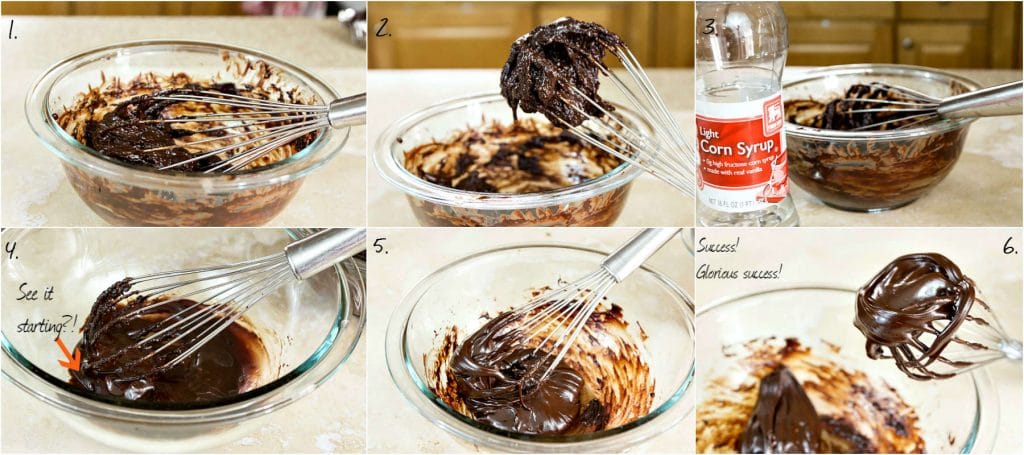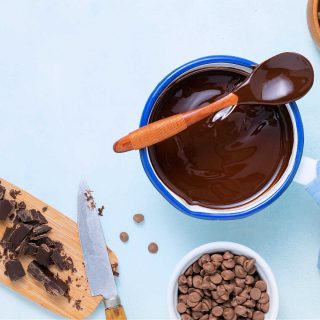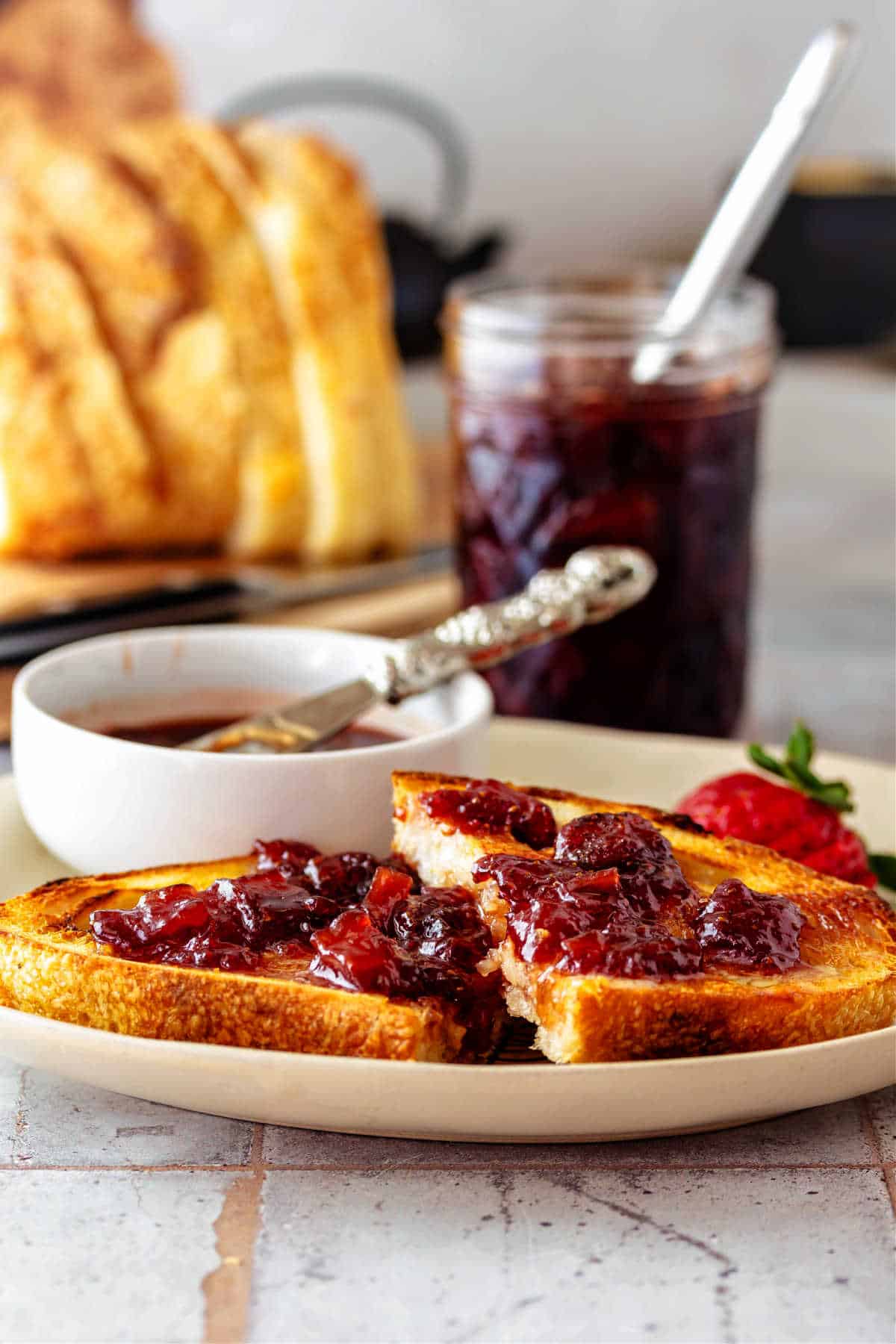Today’s post is all about how to save broken, separated, or split ganache.
Have you ever had a ganache break? If you have, you’d know it. What is meant to be a satiny smooth, glossy, thick emulsion turns lumpy and grainy with liquid fat running all over the place. Very sad.
Worry not though, because I am here to tell you how to fix broken ganache. There are plenty of tutorials out there that tell you how to save split ganache, and they all are effective as long as you don’t mind that your fixed ganache is now runnier than it was originally.
I’m going to tell you how to fix broken ganache without changing its texture. So, if you were going to make truffle centers, you still can instead of having to punt and make a sauce instead.
A related question you might be interested in learning about is why chocolate mousse gets grainy and how to prevent it. And for ease of browsing, you can find all my Fundamental Friday posts in one place. Thanks for being here!

Why Does Ganache Break?
Before we learn how to fix broken ganache, let’s look at why it breaks in the first place.
(And as an aside, here’s how to make dark chocolate ganache in the first place.)
Ganache is an emulsion of fat (both cocoa butter from the chocolate and the butterfat from cream) and water (from the cream) with wee bits of dry particles (the cocoa solids) evenly distributed throughout the mixture.
Pastry Chef Online Participates in Affiliate Programs. If you make a purchase through one of my links, I may earn a small commission. For more information click to read my disclosure policy
When ganache breaks, it’s very similar to what happens when chocolate seizes. The fat to water ratio is too high (there’s way too much fat in relation to the amount of water present), so the fat decides to join up and leave the emulsion en masse, just pooling freely in the bowl while the cocoa solids clump together to gossip and the water sulks.
Emulsions are uneasy unions, and when they break, they really break.
How To Keep Ganache Smooth and Shiny
The good news is it’s pretty hard to break a ganache when you’re making it as long as you are using enough cream.
Keep your ratio between 2 parts chocolate to 1 part cream (for truffle centers) to 2 parts cream to 1 part chocolate (for a lovely pourable glaze) and you’ll be fine.
Start going towards 3 or 4 parts chocolate to 1 part cream, and the fat will just group together and leave the party.
Another piece of good news is that I made a ganache specifically to break it (you’ll see the photos below), and it took some doing. I kept adding chocolate until it got grainy and all runny with fat.
I started with one part cream and 3 parts chocolate, and although I didn’t measure, it took probably about 5 parts chocolate to finally break it. And no recipe I can think of would ever call for a ganache that stiff.
Tips for Making Ganache That Is Smooth and Shiny
- Make sure the chocolate is chopped into wee pieces. The smaller the pieces, the more quickly it will emulsify and the less chance you have of things going awry. A box grater will make short work of it. And one of my favorite ways to get small pieces and extremely small pieces is to cut the chocolate with a serrated knife.
- Heat the cream to boiling and then pour it into a bowl before whisking in the chocolate. I learned, and many of you maybe learned, to make a ganache by pouring hot cream over chocolate, but unless you dump the cream in all at once, you can run into a seizing problem at the beginning with just a tiny bit of liquid introduced to a large amount of chocolate. It’s a safer bet to stir the chocolate into the cream a bit at a time. Leaving the cream in the pot and then dumping in the chocolate is also a bad idea because some of the chocolate could burn when it hits the still-ridiculously-hot bottom of the pan. Hence the bowl.
- Have your chocolate at warm room temperature if you possibly can. If for some reason you store your chocolate in the freezer or the fridge (why are you doing that?!) let it come up to room temp before making ganache. I’m not certain that anything awful would happen, but it’s not nice to shock our ingredients.
I love this Mercer Culinary serrated knife. We used Mercer knives as the kitchen knives in the restaurant. They're well-made and not super expensive. Since they're not forged, they hold their edge longer, although the downside is they're harder to sharpen. Still, using it for slicing bread and chopping chocolate, it will last you for decades.
How Split Ganache and Seized Chocolate Are Alike
Remember when I said a broken ganache is like seized chocolate?
Seizing happens when a small amount of water or other liquid comes into contact with chocolate while it’s melting–or even after it melts. The water causes all the cocoa solids to clump together, just like sugar does on humid days.
Once the solids gather in a group, the fat wanders off and the chocolate gets grainy, grossly unshiny and clumpily thick. In essence, that’s the same thing that happens with a broken ganache.
The Difference Between Seized Chocolate and Broken Ganache (Fixing-Wise)
Here’s a key difference:
When chocolate seizes and you add more liquid to it to get the cocoa solids to unclump so the fat can re-disperse, you can’t use it for tempering since the structure is altered. But you can use it as an ingredient.
With ganache, if you fix it the way I recently learned how to fix it, you can use it for whatever purpose you were originally making it for because you can save separated ganache without changing its texture.
Yes, you heard me right. The magic ingredient you can add to ganache to make it smooth and glossy again doesn’t alter the texture of your ganache, so whether you were going to use it for candy centers, a cake filling or a glaze, you can get right on with your business without missing a beat.
How To Fix Broken Ganache Without Changing Its Texture
I learned this in a “tip trade” from a friend who makes wonderful handmade candies and chocolates every year for her husband to give out as gifts to his clients.
She asked me how to soften cold butter really quickly without its melting, and in “payment,” she shared this tip she learned from Andrew Shotts, incredibly talented chocolatier and owner of Garrison Confections in Rhode Island.
I am pretty sure she read it in his book, (affiliate link) Making Artisan Chocolates* (2007), although she could have taken a class with him. I will have to ask her.
Would you like to save this post?
Regardless, this is what Andrew Shotts does to rescue broken ganache. I thought it was the best tip ever, so I checked with her to make sure I could share it. She said yes, so here goes.
Process Shots: Fixing Broken Ganache
This is a really straightforward process.

- The broken ganache.
- See how clumpy and awful?
- Corn syrup to the rescue!
- Smoothing out nicely.
- Tada!
Look how thick the ganache is in the photos. I added enough chocolate that it would break the ganache which caused it to be Very Super Thick.
I would never–and I bet you would never–make a ganache this thick on purpose.
Even with it being super thick, this trick worked like a charm. I had to fix my ganache one other time for one of the glazes on the Chocolate Espresso Pound Cake I made awhile back.
That ganache was much looser than this one, and it worked so well it seemed like magic. That’s when I messaged Leslie to make sure it was okay to share with everyone.
I wish I could tell you that I understand exactly what is happening when you whisk the chocolate into the corn syrup that makes it get magically smooth again.
Maybe it’s the type of sugar in corn syrup, or maybe it’s the particular combination of water and sugars that make up corn syrup. I honestly don’t know, and I can’t seem to find that information anywhere.
But as much as I like to understand the how and the why of things, I am happy to report that the what in this case works! And if I ever do find an answer to my how and why questions, and I may just email Chef Shotts and ask him, I’ll update the post.
Do You Have To Use Corn Syrup To Fix Broken Ganache?
No, you don’t!
If you are not a fan of corn syrup for whatever reason, I have had people tell me that they have had success fixing ganache using maple syrup and agave.
I am willing to bet that any liquid sugar would do: honey, molasses, sorghum, etc, although I have not tried it.
I really hope this little tutorial helps, you guys!
If you try it, please let me know, either in the Pastry Chef Online Facebook Group or on instagram by tagging @onlinepastrychef and using hashtag #pcorecipe.
I’d also love to have you join my PCO newsletter, The Inbox Pastry Chef!
Thanks, and enjoy!
Questions?
If you have any other questions about this tutorial or any of my recipes, please don’t hesitate to get in touch.
You can leave a comment here, and I will be back in touch in about 24 hours.
If your question in more urgent, you can email me and I answer within about 4 hours.
Either way, I promise to help!
Recipes Using Ganache
Don’t forget that ganache makes a super easy ice cream sauce, friends.
And made with different proporitions of cream to chocolate, you can make truffle centers or even whip it to make a lovely, fluffy frosting.
My fudgy black forest cake also gets a garnish of rich ganache, so take a look at that guy!

How to Fix Broken Ganache (without changing its texture)
Would you like to save this post?
Ingredients
- 1 Tablespoon of your broken ganache
- 2 Tablespoons corn syrup
Instructions
- Put about a tablespoon of the ganache in a dry bowl. Separate a bit of your split ganache out of the main batch and put it in its own separate bowl.
- Bring approximately 2 Tablespoons of corn syrup to a boil. Put the corn syrup in a small microwave-safe bowl and heat it until boiling. With such a small volume, this only takes a few seconds.
- Whisk half the boiling corn syrup into the small amount of broken ganache until it is smooth and shiny again. You only need one tablespoon of corn syrup, but heating that little amount can be tricky. That’s why this method has you heat up more than you need and then just take out the tablespoon.
- Add the rest of the broken ganache a bit at a time. Continue whisking in more and more of the broken ganache into your newly re-emulsified “seed ganache” until it’s all incorporated and the whole batch is smooth and glossy, just like perfect ganache should be.
Did You Make Any Changes?
Notes
And that’s it. Super simple, and it works! And most importantly, the texture of the ganache isn’t altered, or it’s altered so imperceptibly as not to matter.

Hi, y’all! I hope you’ve enjoyed this post and hopefully also learned a thing or two.
If you like my style, I invite you to sign up for my occasional newsletter, The Inbox Pastry Chef.
Expect updates on new and tasty recipes as well as a bit of behind-the-scenes action. I hope to see you there!
Thanks for spending some time today learning how to save your ganache!
Take care, and have a lovely day.



Join in Today!


Off topic, but could you possibly share your tip for warming up/softening cold butter quickly without melting it? That would be so very useful!
I found your article whilst Googling possible ways to fix my mum’s broken chocolate ganache (two parts Trader Joe 70% pound plus bar to one part heavy cream), but by the time I’d found some suggestions online, she was already smearing the runny, grainy mess all over the chocolate stout cake she’d baked for my dad’s birthday. Oh mum, you’re so impatient sometimes!
I actually do use the microwave, but I cut the butter up into pieces–maybe 8-10 per stick–and put them in a single layer on a plate with a little space between them, and then microwave them for maybe 10 seconds at a time on power level 2 until it’s as soft as I want it. It works well, but you have to go slowly and on a low power level to make sure the butter doesn’t fall out of emulsion (separate).
I’m impatient like your mom sometimes, so I get it! Hopefully she could spread a thin layer of something else over the broken ganache. And it will still taste good. It’ll just have an off texture. Happy Birthday to your day!
I’ve seen ganache made online for years, and I’ve been hobby baking for over ten years now, so when I decided to make a white chocolate cranberry tart for christmas that’s topped with a white chocolate ganache I thought, how hard could it be?
I don’t know what I did wrong, but it was a split, oily mess and I tried reheating it and an immersion blender as suggested by the internet, but it just stayed thin and continued to split. I came across this trick and it fixed it almost INSTANTLY! In no time at all it had turned into the glossy, smooth goodness I know ganache is supposed to be.
The corn syrup boiled in about 15 seconds in the microwave, and after the first tablespoon of ganache I added the rest 2 – 3 tablespoons at a time, whisking it in fully between each addition, and it was proper ganache. The golden corn syrup didn’t even noticeably discolour it!
What I’m saying it thank you, you saved Christmas lol
Hooray, Laura! I’m so glad it worked as advertised, and it’s great to know it works for white chocolate too, which is notoriously finicky! Have a wonderful Christmas!
10/10 – had an emergency split ganache at like 11pm the night before an event and an un-iced cake – never heard of adding corn syrup before but after trying all (ALL) of the internets suggestions I gave this a shot – perfect! I’m in the UK so no corn syrup but liquid glucose worked perfectly. Thank you so much!